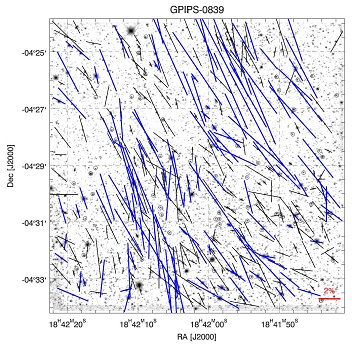The Galactic Plane Infrared Polarization Survey (GPIPS)
This newly launched GPIPS web site is still in progress, but does offer the full set of reduced data products for Data Release 4 (DR4), as of March 23, 2020 (with updated data posted to the data pages on July 10, 2020). See the menu at left for the working items. More to come (watch the News page). DC
NEW -> GPIPS at IRSA! With search tools! See: https://irsa.ipac.caltech.edu/data/GPIPS/overview.html
-> GPIPS at CDS! With search tools! See: http://vizier.u-strasbg.fr/viz-bin/VizieR?-source=J/ApJS/249/23
Click on the thumbnail image above to see the full-sized plot for this field of view.
Q: What am I seeing in this picture?
A: This is one 10×10 arcmin field-of-view (FOV) from the GPIPS survey (comprised of 3,237 such FOVs), obtained using the Mimir instrument on the 1.83m Perkins telescope. The background reverse gray-scale image shows the deep photometric image obtained in the near-infrared H-band (1.6 um) from the 96 images obtained toward this field. The lines represent the linear polarization values measured for the stars at each line center. Line lengths show the polarization percentage measured, with the red 2% reference line at lower right. The orientation angle of each line displays the measured polarization position angle on the plane of the sky, which is expected to follow the sky projection of the orientation of the magnetic field that is mixed in with the dust grains that create the weak polarization signature. Black lines represent stars brighter than 12.5th magnitude in H-band for which the measured polarization uncertainty is below 2% (the “UF1” stars described in the DR1 paper; Clemens et al. 2012c) and the measured polarization exceeds its uncertainty (a ‘detection’). Black circles represent polarization non-detections for stars meeting the same magnitude and polarization uncertainty criteria. Thicker, blue lines represent stars for which their debiased polarization is more than three times their polarization uncertainty (the “UF0” stars in Clemens et al. 2012c).

